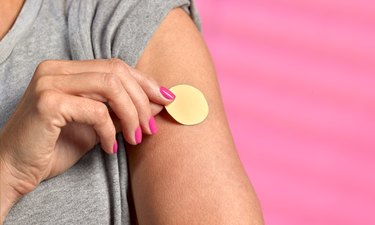
Nicotine was first promoted as a weight loss aid for women in the 1920s. The manufacturer of Lucky Strike cigarettes advertised its product as a better choice for weight control than sweets. The ad campaign was eventually followed by research. In the March 1995 issue of "Health Psychology," researchers reported that smoking increased energy expenditure by as much as 9.7 percent in normal weight women, although women with obesity showed a much lower effect on energy expenditure.
Nicotine
Video of the Day
Nicotine is a chemical found in the dried leaves of the tobacco plant. It is addictive and people who try to quit can suffer withdrawal symptoms that include irritability, sleep problems, nervousness, headaches and tobacco craving. Smoking has been clearly linked to heart disease, lung cancer and lung diseases such as emphysema. Tobacco containing nicotine can be smoked, chewed or absorbed through the mucous membranes in snuff. Other nicotine products include chewing gum and patches, which allow nicotine to be absorbed through the skin.
Video of the Day
Nicotine and Appetite
Nicotine appears to act as a weight suppressant by reducing the appetite. The effect of nicotine on appetite is particularly notable when a long-term smoker stops smoking; weight gain is a common result. According to research published in the December 2002 "Journal of Neurobiology," 70 to 80 percent of people who quit smoking will begin to overeat and gain weight, with women more likely to experience this problem than men. The article emphasizes that nicotine shows this weight suppression effect whether administered by smoking or any of the other "smokeless" routes.
Nicotine Patches
Nicotine patches are used in smoking cessation programs to help people wean themselves from tobacco dependence. The nicotine is provided through a gel attached to an adhesive patch. Each day, the patient takes off the current patch, removes a protective liner from a new patch and applies the patch to a clean, dry, hairless area on the trunk or upper arm. Nicotine is then absorbed through the skin. Each new box of patches has slightly less nicotine, until the patient is eventually nicotine-free without withdrawal symptoms.
Considerations and Warnings
According to Drugs.com, nicotine in any medicinal form should be used as part of a program to stop smoking. Weight loss is not one of the indications for nicotine patches, and nicotine in any form can interact with medications and have side effects. Nicotine patches can cause irritation of the skin, diarrhea, heartburn, abdominal pain and dry mouth. You should not try to self-manage your weight by using nicotine patches. If you have questions about weight control, consult a health care professional.
- “Health Psychology”; Relationship Between Obesity and the Metabolic Effects of Smoking in Women; J.E. Audrain, et al.; March 1995
- Vanderbilt University: Nicotine as a Means for Weight Control: Advantage or Disadvantage?; Carrie Paulus
- “Journal of Neurobiology”; Nicotinic Receptor-Mediated Effects on Appetite and Food Intake; Young-Hwan Jo, et al.; December 2002
- Drugs.com: Nicotine